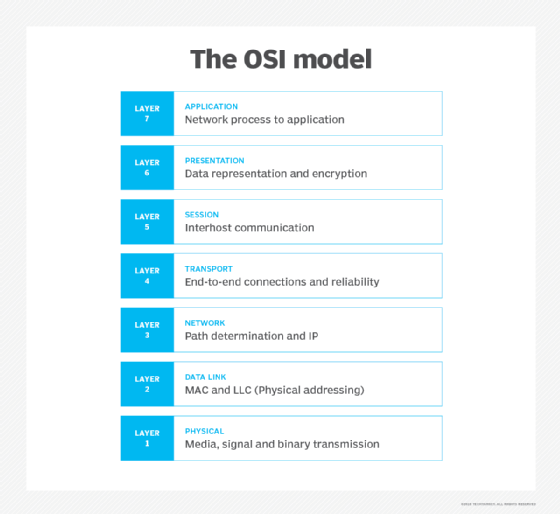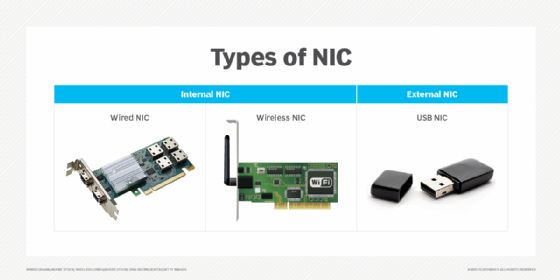What is a network interface card (NIC)?
A network interface card (NIC) is a hardware component, typically a circuit board or chip, installed on a computer so it can connect to a network. Modern NICs provide functionality to computers, such as support for input/output interrupt, direct-memory access interfaces, data transmission, network traffic engineering and partitioning.
The term network interface card is interchangeable with the terms network interface controller, network adapter and local area network (LAN) adapter. Regardless of the term used, the NIC's main purpose is to allow a computer to connect to a network and to enable communication and resource-sharing among data communication equipment.
What is a network interface card used for?
A NIC provides a computer with a dedicated point of connectivity to a network. This network may be a LAN, wide area network (WAN) or even the public internet. NICs transmit and receive packets between the network and endpoint. They convert data from analog to digital (from the network to the device) and digital to analog (from the device to the network). They also manage data flows to control traffic and maintain optimal network performance.
To communicate on any type of network, a device -- also known as a node or endpoint -- must have a NIC installed. Most modern computers have built-in NICs, although NICs can also be inserted into devices' expansion slots to enable network connectivity.
NICs allow computers to connect to a network at much higher speeds than possible with legacy technologies such as dial-up modems. They also reduce network collisions by using algorithms and protocols. Some NICs also use error correction codes to detect and correct errors, thus enhancing data integrity.
Modern NICs also include built-in firewalls to increase network security. Additionally, wireless NICs eliminate the noise of external wiring, thus minimizing transmission disruptions and increasing communication reliability.
How does a NIC work?
The Open Systems Interconnection (OSI) model helps describe how NICs work -- sending signals at the physical layer, transmitting data packets at the network layer and operating as an interface at the TCP/IP layer. In a computing device, a NIC contains the physical layer circuitry necessary for communicating with a data link layer standard, such as Ethernet or Wi-Fi. Each network interface card represents a device and can prepare, transmit and control the data flow on the network.

The NIC operates as a middleman between a computer and a data network. For example, when a user requests a webpage, the computer passes the request to the network card, which converts it into electrical impulses.
A web server on the internet receives these impulses and responds by sending the webpage back to the network card as electrical signals. The card receives these signals and translates them into the data that the computer displays. NICs use unique MAC addresses to identify devices on a network and ensure that data packets go to the correct device.
NICs were originally implemented as expansion cards that could plug into a computer port, router or USB device. However, more modern network cards are built directly into the computer's motherboard chipset. Users can purchase expansion card NICs online or in retail stores if additional independent network connections are needed. When users choose a NIC, its specifications should correspond with the network standard.
Types of NICs
The standard NIC is a plastic circuit board that slides into a computer to connect with the motherboard. However, this connection can occur in multiple ways, which is why many types of NICs are now available.

These include the following:
- Wireless. NICs that use an antenna provide wireless reception through radio frequency waves. The antenna communicates with a wireless access point via the RF waves. Wi-Fi connections use wireless NICs.
- Wired. These NICs have input jacks made for cables. Ethernet is the most popular wired LAN technology.
- Fiber optics. Some NICs use fiber optic cables to connect nodes to networks. These NICs may be used as a high-speed support system for network traffic handling on server computers. It's also possible to achieve this support by combining multiple NICs. Fiber optic NICs are typically more expensive and complex than Ethernet wired NICs.
- USB. These NICs provide network connections through a device plugged into the USB port. USB NICs are ideal for portable computers (e.g., laptops) and for devices that don't already have built-in NICs.
- Peripheral Component Interconnect (PCI). This is an older category of NICs, created in 1992, with fixed width (32 bit and 64 bit) and that used parallel interfaces to support slow network data transfer speeds. They were commonly used in servers and desktop PCs in the 1990s.
- Peripheral Component Interconnect Extended (PCI-X). Created in 1998, this enhanced version of PCI offered higher data transfer speeds (up to 1024 MB/s) and was designed to meet the demanding needs of servers.
- Peripheral Component Interconnect Express (PCIe). This next generation of NICs, created in 2003, use serial communication to offer even higher data transfer rates and lower latency than PCI-X; they are typically installed in computer and server motherboards.
- Mini Peripheral Component Interconnect Express (Mini PCIe or mPCIe). This flexible NIC has a small form factor, making it suitable for space-constrained devices like laptops and mobile phones, as well as industrial automation, vehicles and shock-sensitive applications.
NIC components
While the design and size of NICs may differ, they all include some common components:
- Controller: Every NIC contains a controller, which is its central component (similar to a computer's CPU). The controller is responsible for processing received data and directly influences the NIC's performance.
- Driver. This software passes data between the computer's operating system and the NIC. When a NIC is installed on a computer, its corresponding driver software is also downloaded. Drivers must stay updated and uncorrupted to ensure optimal performance from the NIC.
- Boot ROM socket: NICs include a socket or slot that allows diskless devices to connect to the network. Boot ROM (sometimes written as one word, Bootrom) removes the need for a disk to enable network connectivity, thus reducing hardware costs. Booting via the network can also enhance security.
- Bus interface. This connects the NIC to the motherboard.
- LED indicator. Most NICs have an LED indicator integrated into the connector to notify the user when the network connects and data transmission occurs. Simply put, the indicator shows the NIC's working status (connected or not connected to the network).
- NIC interface port. This provides the physical connection point between the NIC and the network to exchange data signals, often using an Ethernet cable or transceiver.
- Router. Sometimes a router is needed to enable communication between a computer and other devices. In this case, the NIC connects to the router, which is connected to the internet.
- Bracket for expansion slots. NICs that need to be placed into a device's expansion slot require a profile bracket. Brackets are available in both compact and standard sizes.
Key NIC features
These features can differentiate one NIC from another:
- Speed. The NIC speed refers to how fast data can travel over a network. All NICs have a speed rating -- listed in megabits per second (Mbps) or gigabits per second (Gbps) -- that determines the card's performance in a network. If the network's bandwidth is lower than the NIC or multiple computers connect with the same controller, the labeled speed decreases. Ethernet NICs commonly come in 10 Mbps, 100 Mbps, 1 Gbps, and 10 Gbps varieties. Higher-speed NICs (40 Gbps and above) are also available for high-end data transfer and high-performance computing tasks.
- MAC address. A unique, unchangeable MAC address, also known as a physical network address, is assigned to each NIC. MAC addresses deliver Ethernet packets to the intended endpoint.
- Interrupt support. Some NICs can trigger interrupts to notify the device CPU that an event has occurred (e.g., the device is receiving data). The interrupt is the CPU's signal to stop its current work and process the data. Modern NICs also use interrupt moderation, in which they wait for more packets to arrive before generating an interrupt, thus reducing the number of times the CPU gets interrupted.
- Direct memory access (DMA). Some NICs use DMA technology to access memory locations directly without involving the CPU. This allows the CPU to offload some of its data transfer tasks, enhancing system performance, and thus speeding up data movement and reducing latency. These NICs are often known as smartNICs.
- Security features. Modern NICs include numerous security features such as built-in firewalls, encryption capabilities and intrusion detection to protect data transmissions. Some NICs also use authentication protocols such as Password Authentication Protocol to authenticate users and prevent unauthorized or malicious users from accessing the network.
SmartNICs transfer packet processing duties from server CPUs, optimizing application performance. They can perform tasks such as packet capture and load balancing. Explore our introduction to smartNICs and their benefits.








